Norrland Dragoon Regiment
The Norrland Dragoon Regiment (Swedish: Norrlands dragonregemente), also K 4 or K 8, was a Swedish Army cavalry regiment located in the province of Lappland that traces its origins back to the 17th century. It is still in active service as the Norrland Dragoons detachment of Norrbotten Regiment (I 19), still located in Arvidsjaur. The current name of the fighting unit is the Army Ranger Battalion.
| Norrland Dragoon Regiment | |
|---|---|
| Norrlands dragonregemente | |
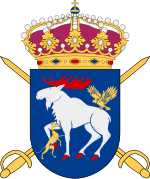 | |
| Active | 1893–2004 |
| Country | |
| Allegiance | Swedish Armed Forces |
| Branch | Swedish Army |
| Type | Cavalry |
| Size | Regiment |
| Part of | 6th Military District (1853–1893) 6th Army Division (1893–1901) VI Army Division (1902–1927) Northern Army Division (1928–1936) Upper Norrland's Troops (1937–1942) VI Military District (1942–1955) Västerbotten Regiment (1955–1976) Upper Norrland Military District (1976–1993) Northern Military District (1993–2000) Joint Forces Command (2000–2004) |
| Garrison/HQ | Arvidsjaur |
| Nickname(s) | Norrland's Dragoons Blue Dragoons |
| Colors | Blue and orange-yellow |
| March | "Norrlands dragoners marsch" (Carlsson)[note 1] |
| Anniversaries | 20 September |
| Battle honours | Nowy Dwór (1655) |
| Insignia | |
| Branch insignia | 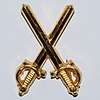 |
| Unit insignia | .jpg) |
| Cap badge | 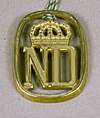 |
Units from AJB have been involved in Afghanistan, Bosnia, Kosovo, Pakistan, Ukraine and Chad (continuously in Afghanistan since 2004).[2]
History
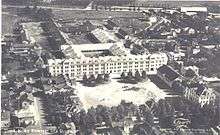
The regiment has its origin in the Ångermanland, Medelpad and Jämtland Regiment raised in 1646. From 1689 on, this regiment was named Jämtland Dragoon Regiment, but had only one company of cavalry troops. This company was semi-separate, with the name Jämtland Cavalry Company (Jämtlands kavallerikompani) and had been split off from Bohus-Jämtland Cavalry Squadron in 1670. The company was renamed Jämtlands hästjägarskvadron in 1802 and after receiving another squadron it was organized into a battalion and renamed Jämtlands hästjägarkår in 1834.
The corps gained full status as a separate unit in 1853 and was given the designation K 8 (8th Cavalry Regiment). It was renamed Norrland Dragoon Regiment in 1892 and when merged with parts of the Crown Prince's Hussar Regiment in 1927 it was redesignated K 4 but kept its name before being reorganized to a battalion and renamed Norrland's Dragoons in 1958. Finally the regiment was renamed back to its old name in 1980.
See also the history for Jämtland Ranger Regiment.
Organization
1833
- Livskvadronen
- Alsens skvadron
See also the organization for Jämtland Ranger Regiment.
Heraldry and traditions
Colours, standards and guidons
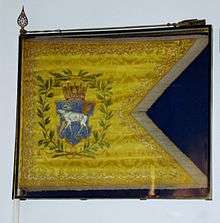
The unit presents one guidon. Its first was presented on 30 September 1902 by major general Casten Warberg.[3] A new one was presented to the regiment by the Chief of the Army, lieutenant general, count Carl August Ehrenswärd at the regimental barracks in Umeå on 20 September 1955. The guidon is drawn by Brita Grep and embroidered by hand in insertion technique by the company Libraria.[4] Blazon: "On swallow-tailed blue cloth the provincial badge of Jämtland; a white elk passant, attacked on its back by a rising falcon and in the front by a rampant dog, both yellow. On a white border at the upper side of the guidon, battle honours (Nowodwor 1655) in blue. Blue fringe."[4] From 1957, the regimental letters as replaced from "NDR" to "ND", when the regiment was to be reduced to a battalion in 1958.[3]
Coat of arms
The coat of the arms of the Norrland Dragoon Regiment (K4) 1977–2004. Blazon: "Azure, the provincial badge of Jämtland, an elk passant argent, attacked on the back by a rising falcon and in the front by a rampant dog both or; all animals armed and langued gules. The shield surmounted two rapiers in saltire or".[5]
Medals
In 2004, the Norrlands dragonregementes (K4) minnesmedalj ("Norrland Dragoon Regiment (K 4) Commemorative Medal") in silver (NorrldragMSM) was established. The medal ribbon was of blue moiré with an orange stripe on the middle.[6]
Other
The regimental anniversary is 20 September, as a memory to the Battle of Nowy Dwór on 20 September 1655.[3] The battle honour is shared with Jämtland Ranger Regiment (I 5).[7]
Commanding officers
Regimental commander 1893–1957 and 1980–2004. From 1957 to 1980, the unit was a training battalion where the commanding officer was called battalion commander and was subordinate to the commander officer of Västerbotten Regiment.[8]
- 1893–1893: Knut Gillis Bildt (acting)
- 1893-1895: Gustaf Magnus Oskar Roger Björnstjerna
- 1895–1904: Gustaf Adolf Löwenhielm
- 1904–1914: Wilhelm Aschan
- 1914–1917: Adolf Adelswärd
- 1917–1919: Henric Ståhl
- 1919–1922: Axel Ahnström
- 1922–1930: Rickman von der Lancken
- 1930–1935: Archibald Douglas
- 1935–1940: Carl Björnstjerna
- 1940–1943: Sven Colliander
- 1943–1947: Henric Lagercrantz
- 1947–1951: Sven David Oskar Hermelin
- 1951–1952: James Axel John Maule
- 1952–1957: Carl Johan Wachtmeister
- 1957–1963: Gustaf William Frisén
- 1963–1972: Ingemar Bondeson
- 1972–1978: Claes Berthold Mikael Dieden
- 1978–1980: Per Blomquist
- 1980–1982: Per Blomquist
- 1982–1984: Lars Wallén
- 1984–1986: Per Stig Lennart Mohlin (acting)
- 1986–1989: Björn Lundquist
- 1989–1992: Mertil Melin
- 1992–1996: Johan Kihl
- 1996–2000: Frank Westman
- 2000–2003: Gunnar Söderström
- 2004–2005: Bengt Sandström
Names, designations and locations
| Name | Translation | From | To | |
|---|---|---|---|---|
| Kungl. Norrlands dragonregemente | Royal Norrland Dragoon Regiment | 1893-01-01 | – | 1958-06-30 |
| Kungl. Norrlands dragoner | Royal Norrland Dragoons | 1958-07-01 | – | 1974-12-31 |
| Norrlands dragoner | Norrland Dragoons | 1975-01-01 | – | 1980-03-31 |
| Norrlands dragonregemente | Norrland Dragoon Regiment | 1980-04-01 | – | 2004-12-31 |
| Avvecklingsorganisation | Decommissioning Organisation | 2005-01-01 | – | 2006-06-30 |
| Designation | From | To | ||
| № 8 | 1834-07-30 | – | 1914-09-30 | |
| K 8 | 1914-10-01 | – | 1927-12-31 | |
| K 4 | 1928-01-01 | – | 2004-12-31 | |
| Location | From | To | ||
| Frösö Camp | 1893-01-01 | – | 1900-10-12 | |
| Umeå Garrison | 1900-10-13 | – | 1980-03-31 | |
| Arvidsjaur | 1980-04-01 | – | 2004-12-31 |
See also
Footnotes
- The march was adopted in 1901 and was established in 1953 by Army Order 33/1953.[1]
References
Notes
- Sandberg 2007, p. 22
- "Archived copy". Archived from the original on 2010-08-29. Retrieved 2013-05-27.CS1 maint: archived copy as title (link)
- Braunstein 2003, p. 143-146
- Braunstein 2004, p. 50
- Braunstein 2006, p. 28
- Braunstein 2007, p. 121
- Braunstein 2003, pp. 105-107
- Kjellander 2003, p. 292
Print
- Braunstein, Christian (2003). Sveriges arméförband under 1900-talet. Skrift / Statens försvarshistoriska museer, 1101-7023 ; 5 (in Swedish). Stockholm: Statens försvarshistoriska museer. ISBN 91-971584-4-5. SELIBR 8902928.CS1 maint: ref=harv (link)
- Braunstein, Christian (2004). Svenska försvarsmaktens fälttecken efter millennieskiftet [The flags and standards of the Swedish armed forces after the turn of the millennium] (PDF). Skrift / Statens försvarshistoriska museer, 1101-7023 ; 7 [dvs 8] (in Swedish). Stockholm: Statens försvarshistoriska museer. ISBN 91-971584-7-X. SELIBR 9815350. Archived from the original (PDF) on 2018-05-22. Retrieved 2018-10-15.CS1 maint: ref=harv (link)
- Braunstein, Christian (2006). Heraldiska vapen inom det svenska försvaret [Heraldry of the Swedish Armed Forces] (PDF). Skrift / Statens försvarshistoriska museer, 1101-7023 ; 9 (in Swedish). Stockholm: Statens försvarshistoriska museer. ISBN 91-971584-9-6. SELIBR 10099224.CS1 maint: ref=harv (link)
- Braunstein, Christian (2007). Utmärkelsetecken på militära uniformer [Decorations on Swedish military uniforms] (PDF). Skrift / Statens försvarshistoriska museer, 1101-7023 ; 12 (in Swedish). Stockholm: Statens försvarshistoriska museer. ISBN 978-91-976220-2-8. SELIBR 10423295.CS1 maint: ref=harv (link)
- Kjellander, Rune (2003). Sveriges regementschefer 1700-2000: chefsbiografier och förbandsöversikter (in Swedish). Stockholm: Probus. ISBN 91-87184-74-5. SELIBR 8981272.CS1 maint: ref=harv (link)
- Sandberg, Bo (2007). Försvarets marscher och signaler förr och nu: marscher antagna av svenska militära förband, skolor och staber samt igenkännings-, tjänstgörings- och exercissignaler (in Swedish) (New ed.). Stockholm: Militärmusiksamfundet med Svenskt marscharkiv. ISBN 978-91-631-8699-8. SELIBR 10413065.CS1 maint: ref=harv (link)
Further reading
| Wikimedia Commons has media related to Norrland Dragoon Regiment. |
- Kungl. Norrlands dragonregemente i ord och bild (in Swedish). [S.l.] 1911. SELIBR 2940857.